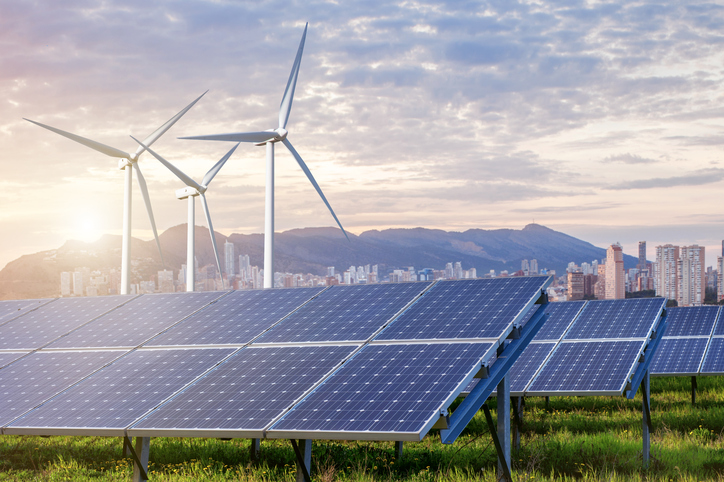
What Does Washington’s Clean Electricity Law Mean for Residents?
Electricity blackouts in Washington will begin a decade from now[1].
By David Boleneus, MBA, MS
Summary
Unfair advantage is being taken of electricity customers, a “con game”. The Democratic legislative magicians in 2019 erred in writing Washington’s Clean Electricity Law by ruling how homes and businesses will be heated and electrified in the future on the basis of propaganda, opinion, fallacy, and without evidence (while ignoring clear and overwhelming scientific evidence to the contrary) that the climate would be destroyed if the Democratic majority failed to act.
The Law outlaws use of reliable, proven forms of energy systems from coal, oil and natural gas used for 170 years in favor of unproven so-called “new”, “green”, “renewable” energy systems. This paper examines energy supplies, the poor reliability and performance records and insurmountable problems that plague the new energy systems. The local natural gas and electricity provider says to expect blackouts because it must curtail electric supply when the “new” replaces the “old” energy systems in a decade, that begin 2030 and accelerate through 2045 in 25 years. Only by magical trick can “new” energy that now supplies 6/10 of one percent of today’s energy world-wide supply 100% of Washington’s energy by 2030.
The Democratic legislature ignores the long unsatisfactory, under-supplied and ill-performing histories and unfavorable treatment of customers in other countries where the “new” energy has caused utility bills to skyrocket by 460% (Ontario’ Green Energy Act, 2009, Canada) to 555% (Germany, Denmark) to 610% (Australia) and forced customers to suffer after forced disconnects from the electricity grid.
Washington’s electric customers need to have a conversation about their electric supplies because the new law will make changes and customers have only a short time to voice concerns in how the change will occur.
Why, you ask will there be blackouts? How many? you might ask. Blackouts would be caused by an inadequate supply of electricity. The electricity will not be there because Washington’s new Clean Electricity Law, are brought to you in the form of SB5116 by the Democratic majorities in the House and Senate of the State at the urging of governor Inslee. The new law takes great risks with electric supply that lawmakers understand only to the extent they can operate a light switch because the technology is unknown, inadequate and they have ignored history and ill-experiences elsewhere. Lawmakers cannot guarantee a supply under the conditions the law they have written requires. These leaders are terrified of carbon dioxide, the key reason for the law. But it’s impossible for Carbon Dioxide to affect climate, a false pretense driving the new law. Carbon dioxide helps plants grow to feed agricultural crops that feeds people and creates millions of jobs for agricultural workers and family farms in our state. Is it the wish by the Democratic majorities and the governor that family farms and agriculture and agricultural workers disappear?
Electricity Supply in Washington
This brief first will address supply and then go on to explain one or two of the many problems with renewable forms of energy that lawmakers say will be the “new” energy to replace the old energy of the “past”. The Clean Electricity Law outlaws the use of natural gas, petroleum and coal to generate electricity in a decade, or January 2030. We have ten years and a few days until then. Fossil fuels now generate 27% of our electricity in the state. Below is today’s electricity supply (excluding transportation fuels), by each fuel source for Washington, 12.7 billion kilowatt-hours to September 2019, a 13.9 percentage increase from 2018. A typical residence uses 12,000 kilowatt-hours per year.
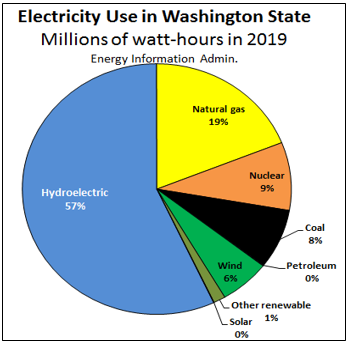
The second illustration shows what to expect in 2030 after natural gas, petroleum and coal are outlawed. Amazingly, 27% of our electric supply needed becomes unavailable. It is outlawed. For simplicity we assume electricity use is unchanged from 2019 to 2030 although historic U.S. census data shows that the number of households increases by 0.7% per year, so by 2030 the number of households in the State would increase by 268,000. This is a nightmare scenario because it is the same as denying electricity to 850,000 of 3,148,000 Washington’s households with the total of those denied electricity increasing to 1,118,000 by 2030.
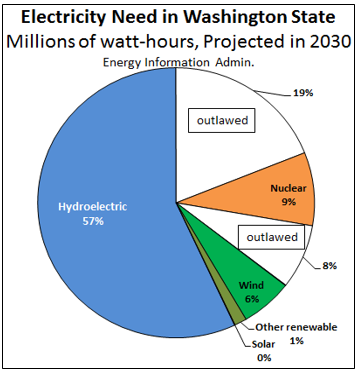
What About Renewables?
The new law anticipates that renewables will fill any voids, overcome any problem with energy supply that might come. Many assume this holds true. The disadvantages are in the details. But will this happen as predicted? Other countries and states in the US have many years of unfavorable experience with renewables. Are lawmakers aware of these experiences? Apparently not.
Experience with roll-out of renewables comes with major and serious problems that are unavoidable:
(1) electric generation is intermittent and unpredictable; on average wind turbines require a backup power source (another power plant, not wind) 80% of the time
(2) renewable generation does not match periods of demand resulting in high cost and wasted electricity and no reliable battery storage is available to capture the unusable electricity; this is energy mis-match, well known in German and Ontario experience;
(3) renewables require hugely expansive of facilities requiring 1,000 times to 10,000 times more land than traditional sources; its called energy density and wind have very little;
(4) low frequency noise, or infrasound, generated by wind turbines is linked to serious or debilitating health concerns;
(5) renewable facilities nearby, within 10 miles, that lead to health concerns under study by medical professionals
(6) wind turbines diminish real estate values and tourism;
(7) renewable facilities have lifetimes 50% or 75% shorter than traditional power sources, thus requiring additional cost; and
(8) renewables only exist due to government subsidy (tax) support from all Americans with the subsidy allowing large monetary and unfair competitive advantage of renewables over traditional and full-time electric sources. All of these problems are well documented and add costs to increase the price of electricity without an increase in supply or reliability. Ontario estimates its wind-generated electricity costs $0.44 per kilowatt-hour. Electricity cost, where wind turbines are widespread is 40.3 US cents in Germany and 47.1 US cents in South Australia. For comparison, we pay $0.08 per kwhr from the local utility company.
(9) high cost electricity in Ontario placed 34% of Ontarians with incomes below $47,7000 into energy poverty; disconnects from electric power grew by 62,730 households in three years after Green Energy Act passed;
(10) due to inefficiencies of wind, the 46 wind farms in WA-OR provide only 35% of the electric supply as provided by the four Snake River dams even though the capacity of wind turbines exceeds capacity of the 4 Snake River dams by 37%; electric output of 4 dams exceeds electricity produced by 46 wind farms for 26 to 30 days each month.
(11) building a sufficient number of wind turbines for Washington state will cost approx. $4 trillion; duplicating the same feat for 13 other states resources for their construction would exhaust all known world supplies of copper, molybdenum, iron ore for steel, cement and rare earth elements and prevent any further expansion of renewables in the U.S. beyond the 14 states; the mineral resource requirements for the 14 states would require opening of 20 mines in the Cascade Mountains, including Wilderness areas, National Parks and National Forests to recover the copper, molybdenum, silver and gold for the wind turbines.
(12) building a Green New Deal in Washington will be prevented, stopped, by any one of the additional twelve (12) fatal flaws identified and inherent with renewable energies
Let’s begin here to address two of the problems: intermittent supply and then move on to the risk to human health of residents living near wind turbines.
Wind is Intermittent, Not reliable
Wind is an intermittent source of power, and a fact of nature. The American Wind Energy Association regularly makes news headlines advertising that thousands of new megawatts of wind energy electric generating capacity were added each month or every year. There are two problems with boasting about wind turbines that fails to be truthful. The electricity produced or generated is only a fraction of the capacity of the turbine, from less than 5% to 25%. When efficiency falls far below capacity, a backup power source must be called upon to provide supply full-time.
What’s wrong with wind: 2,271: anti-wind websites at www.quixoteslaststand.com; and more at…. www.epaw.org European Platform for Windfarms; www.aweo,org; www.ontario-wind-resistance; www.stopthesethings.com; www.joannova.com (Australia);
www.masterresource.com; Energy Matters: www.euanmearns.com; www.heartland.org; www.notrickszone.com; Energy
Probe www.ep.probeinternational.org
The intermittency is clearly a fact with the 4,782 megawatts (~3,180 turbines if 1.5 MW each) of electric generating capacity of the 46 wind farms across Washington and Oregon. More below.
The wind is often not available to move the turbines under the poor wind generating periods that are commonplace during the inclement winter-time conditions from October through February exaggerates wind inefficiencies by 200% to 300% each year. Wind electric generation is intermittent and unreliable as a full time source of electricity because, during the low wind conditions, wind farms require a backup from another source of power for 80% of the time if full time electricity is desired. This uncovers another problem. The backup to get full-time power comes from coal, petroleum or natural gas plants, nuclear plants, imported supplies from these, or hydroelectric dams. In Washington it is less clear as to the backup source but we presume the backup comes from hydro.
The third graphic provides a closer look into demand and supply on the Bonneville Power System. Take special notice of the red (wind generation) in the hour-by-hour records for 7 days in February 2019. Notice at the bottom (red bars, one per hour) that there is little or no wind for the first three days although the wind capacity during this time is advertised as 2,764 megawatts (red horiz. line). Wind generation never gets to 50% of its capacity. It is clear that the system load is there, is demanded, but the wind generation is failing, so the other sources must supply its failure.
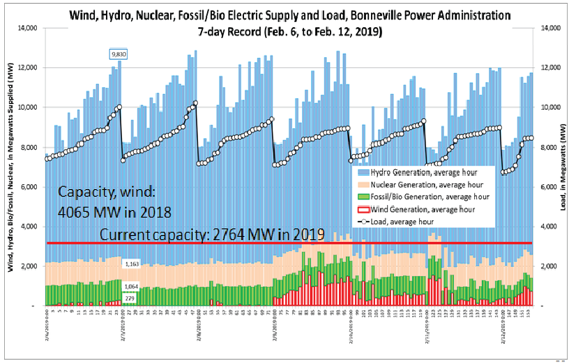
The fourth graphic below illustrates the intermittent generation of electricity from the 46 wind farms in Washington and Oregon during all of 2018. This is hourly data for 8,760 hours for the year for the system with 4,782 MW of capacity. Analysis of wind electricity generation data for 2018 reveals these performance characteristics: Electric generation was….
..below 5% of capacity for 3,092 hours (35%),
..below 4% of capacity for 2990 hours,
..below 1.25% of capacity for 1,663 hours (63 days, 19%) over the 8,760 hours of the year according to data from
Bonneville Power Administration, the agency charged as balancing authority of energy region-wide. The red and green arrows indicate periods of “no electricity generated” of 6 days in January, 11 days in October and 12 days in Nov.-December. There are more periods of “no generation” than I have arrows to label. How many are there?
The state of Washington cannot rely on electric sources that take regular vacations, as wind does, or sources that cannot provide full-time supply. Washington needs 100% of supply 24/7 all of the time.
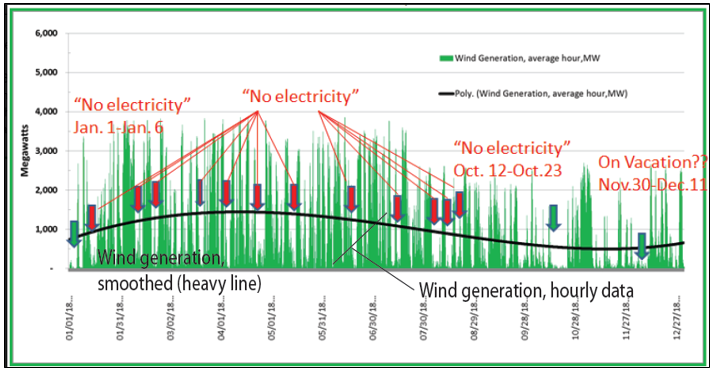
How many days is no electricity generated or with generation at less than 5% of capacity? The table below shows the number of days each month for a total of 265 days for the 776-day period of January 2013 to February 2015 that electric generation from Washington-Oregon’s 46 wind farms fell below 5% of capacity. The months of October through March are clearly low wind periods, as long-time residents know, providing overcast skies, temperature inversions, snow storms, drizzling rain for days at a time. It reveals a real face of the low wind or “no electricity generation” if relying on wind turbines can add up to 68 to 71 days during October through March period, or 14 to 14.4 days each month. At these times do not rely on your cell phone to communicate, your microwave or conventional oven to cook breakfast or your movie streaming on the 60-inch flat screen or your electric car or electric bus to get to workplaces. Relying on wind turbines to generate electricity is clearly not a rational choice, because when the region becomes inclement, it is a region-wide event that affects all wind farms regardless of that number.
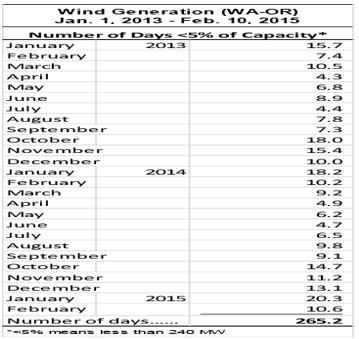
The wind generating capacity from the 46 wind farms is advertised by wind operators as enough energy to supply 3.86 million customers, but when wind farms operate at 5% of capacity for 265 days of the 776 day period (table) means that 3.67 million customers deprived of the electricity promised. Have Washingtonians and electric customers been deceived by wind or renewables. Is the favorable advertising of wind a deception?
Future Electric Supply Adequate or Not
A future filled with wind electric generation reveals vast shortcomings. Although little has been revealed of problems that come by welcoming of renewables, but one question arises. If relying on renewables, has the fuse been lighted by the Clean Electricity Law-SB5116 that will bring this State to a level of inadequate electric supply? Will this impact our economy, transportation, jobs, or family welfare in a decade when fossil fuels cannot legally generate electricity with wind turbines tasked for that? The second question is the unknown cost of relying on electricity sources that are unreliable yet compelled by the new law to become reliable in the face of so many unknowns. Did lawmakers in Ontario know of the costs the electric customers would bear when, in 2009, its Parliament mandated junking its coal plants and building wind turbines and in six years electric costs skyrocketed from $0.03 to $0.36 per kw-hour? Do Washington legislators read histories of the events they mandate? Apparently not.
Let’s look at the future. The governor’s Clean Electricity Law (SB5116) requires 100 percent carbon neutral by 2030, eliminates coal and natural gas fired electricity. Through 2045 electricity from fossil fueled sources can be imported, but not generated in Washington. Electricity generated by coal or natural gas may be used after 2030, but Avista can only do so by purchasing carbon offsets/carbon credits[2] to pay for imports with the customer paying the full cost of the carbon offsets/carbon credits. The business of carbon offsets and cap and trade is another nightmarish scenario but reserved for another discussion. Carbon offsets/credits are bought at carbon exchanges, such as the exchanges in Ontario, California, Manitoba, and the one in Chicago created by Al Gore, although no longer in business. The charade not to use carbon fuels, to buy and sell carbon offsets so others can use carbon fuels at our expense, so legislators can boast “carbon freedom” is a technique of centrally-planned economies called cap-and-trade.
Utility Says Blackouts (“curtailment”) Imminent
Imminent (definition, Wikipedia) Imminent peril, or imminent danger, is an American legal concept where imminent peril is “certain danger, immediate, and impending; menacingly close at hand, and threatening.
The only question is when this will happen or when complaining will result in change. Below is the electric supply predicted (published) by our local utility provider to display two scenarios for periods after 2030 (top, illustration 5) and period after 2045 (bottom, illustration 6). Each shows blackout conditions caused during a cold stretch in January when renewables, like wind as we already know are low, and hydro cannot fill the demand because hydroelectric has been over-promised to others. Customers can expect 68 days to 71 days during each of the 5 winter months when we risk “blackout” conditions if our electric power must rely on renewable forms of power, namely wind turbines.
Scenario 1 in illustration 5 is a prediction of how the supply of renewables will fare when greenhouse gases (GHG) emitted are reduced by 80% as mandated by Executive Order 07-02. We already know that wind turbines cannot provide supply for 14 to 14.4 days per month in any January in the region. Without natural gas, the system is deficient during prolonged stretches of low wind energy. Does this means shortages and how large might they be? Is this a mission impossible? Copied pages from Avista’s April 16, 2019 IRP TAC 3 Presentations, pages 134-137
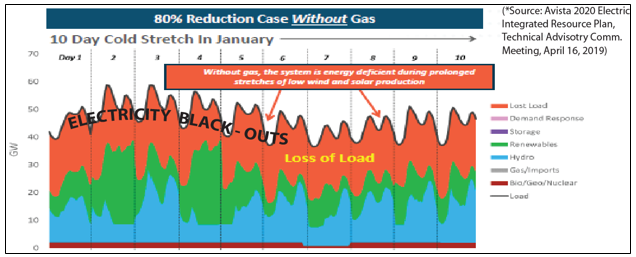
In scenario 2 (below, far right) curtailments, or blackouts are imminent if fossil fuel generated electricity is unavailable at the 0% Gas Capacity Factor (CF) mandate in 2045, just 25 years from today. This is fossil fuel-free condition. Curtailments (red bar) will occur about one-half of the time.
The utility says it will build, or cause to build 23,000 MWs of wind (15,300 wind turbines) in Washington and 24,000 MWs of turbines in Oregon will require an area of 4,770 square miles (more than 3 million acres) or about 7% of the area of the state of Washington, an area that does not include the area of planned PV solar panels. The construction of 31,300 wind turbines, in the end, will not overcome their inability to produce electricity during the five month-long winter months in the region. Copied pages from Avista’s April 16, 2019 IRP TAC 3 Presentations, pages 134-137
· Gas capacity factor declines significantly at higher levels of decarbonization.
· Significant curtailed renewable energy at deep levels of carbon reductions
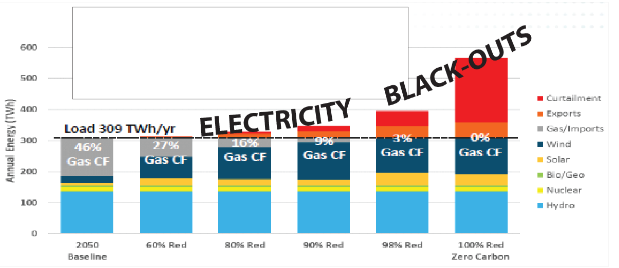
Under these conditions of absolute elimination of greenhouse gases, coming in 25 years, the cost per ton of carbon dioxide that the Clean Electricity Law says must be eliminated ranges from $11,000 to $16,000 per ton.
What this means for fuels: 102 gallons of gasoline or 88 gallons of diesel burned in an engine will yield one ton of carbon dioxide. In the high cost scenario ($16,000 per ton) the tax on carbon dioxide for a gallon of gas is $156.80/gallon and tax on diesel is $181.80/gallon.
These are costs paid by customers although customers will also suffer blackouts to accomplish this condition. Are these costs realistic and do customers understand the pain and suffering coming in the future courtesy of the Washington legislature?
The foregoing has only discussed the supply side of renewable wind. Many other problems were listed (page 2)
Another nightmarish condition are the serious health consequences created by low frequency noise, called infrasound generated by turbines as discussed by medical professionals. If expansion of wind turbines is required, then the impact of sound upon humans must be addressed. A discussion of the hazard of low frequency noise from turbines is reserved for another time.
If you do not agree with the rule making now underway by the WUTC, then get involved and bring change while rules are being considered. Each needs to get involved and comment on rule-making to WUTC.
Here is what you can do. Go to the WUTC website and read recent dockets on rulemaking. Below I have excerpted some examples. There is much more.
Docket UE-190652 EIA Rulemaking
Notice of Opportunity to Comment – Attachment A
Consider the impact on your life and living, and the use of natural gas, or other energy sources derived from fossil fuels, for heating or transportation of the following statement (non-emitting electric generation):
Use of non-emitting electric generation
The Laws of 2019, Chapter 288, §§ 2(28) and 29(2)(m), require utilities, beginning in 2030, to generate or source 100 percent of its electricity from any combination of renewable or non-emitting resources.
QUESTIONS FOR CONSIDERATION
The Commission seeks comment on the draft rule language. To facilitate this inquiry, the Commission poses the following questions for stakeholder feedback. Please comment or recommend changes in the following:
Greenhouse gas emissions reporting:
However, the Laws of 2019, Chapter 288, § 7, does not provide ad default emissions rate for greenhouse gas emissions other than carbon dioxide from un-specified electricity. How should the Commission’s rules specify an emissions rate for greenhouse gas emissions other than carbon dioxide from unspecified electricity? What data source(s) and methodology should the Commission use to establish a default emissions rate from greenhouse gases other than carbon dioxide?
Low-income conservation:
Please propose the level of energy burden that should be included within the definition of “Energy assistance need.” Please explain and provide justification for your proposal. Industry literature suggests an affordability benchmark as low as six percent of household income.
WRITTEN COMMENTS
Written comments in response to the Notice must be filed with the Commission no later than 5p.m. on November 4, 2019. Pursuant to WAC 480-07-250(3), written comments must be submitted in electronic form, specifically in searchable .pdf format (Adobe Acrobat or comparable software). As provided in WAC 480-07-140(5), those comments must be submitted via the Commission’s web portal at www.utc.wa.gov/e-filing. If you are unable to submit documents via the portal, you may submit your comments by email to the Commission’s Records Center at records@utc.wa.gov or by mailing or delivering an electronic copy to the Commission’s Records Center on a flash drive, DVD, or compact disc that includes the filed document(s). Comment submissions should include:
- The docket number of this proceeding (UE-190652).
- The commenting party’s name.
- The title and date of the comment or comments.
The Commission will post on its website (http://www.utc.wa.gov/190652) all comments that are provided in electronic format. If you are unable to file your comments electronically, the Commission will accept a paper document. Questions may be addressed to Andrew Rector by calling (360) 664-1315 or emailing Andrew.Rector@utc.wa.gov.
[1] More information available by email to: boleneus@gmail.com
[2] Al Gore’s company Generation Investment Management sells carbon offsets/credits